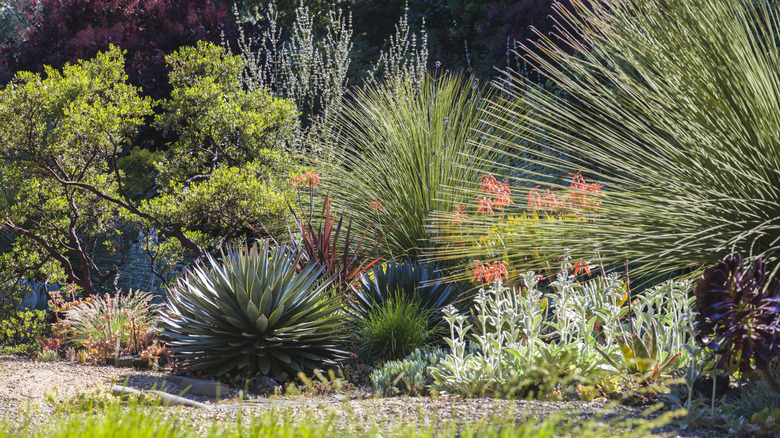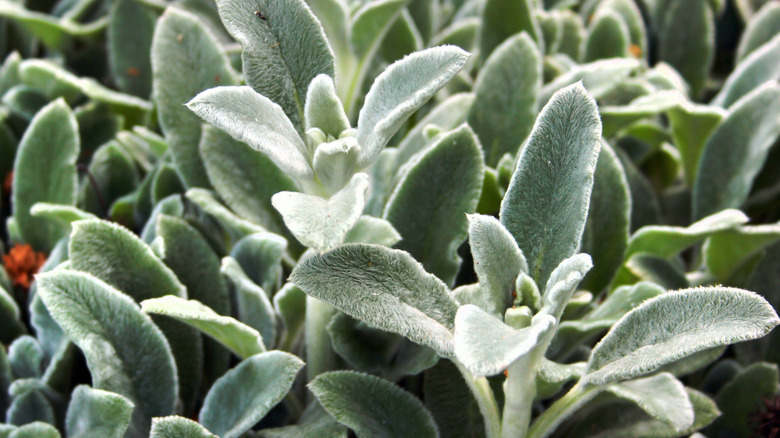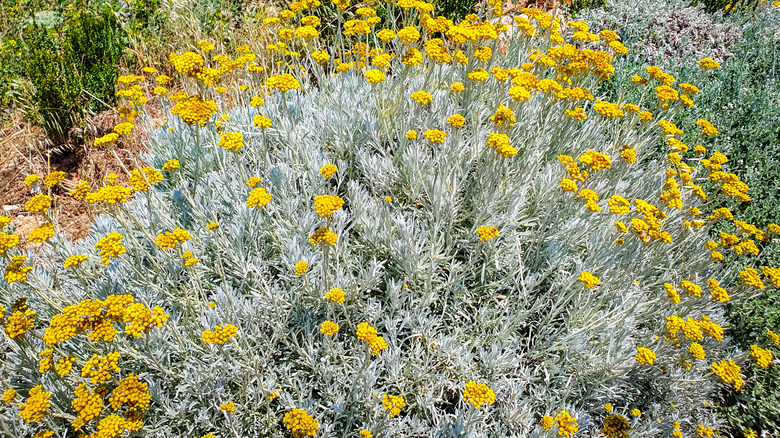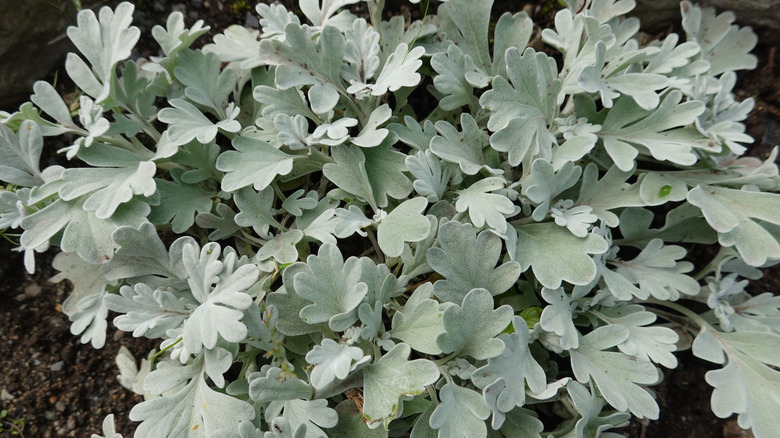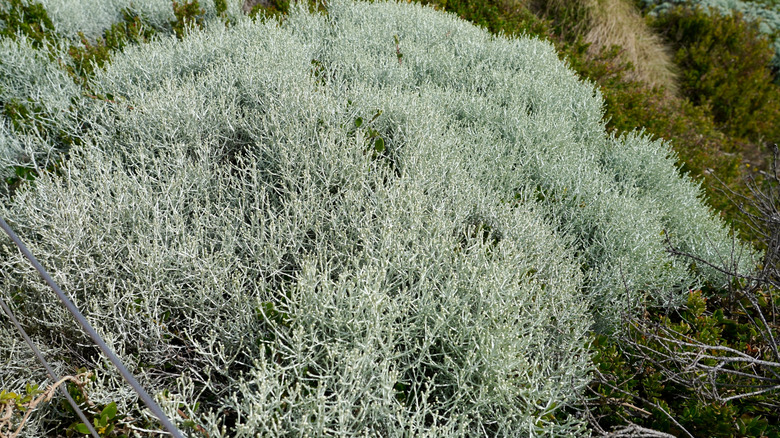Drought-Tolerant, Silver Foliage Plants That Can Beat The West Coast Heat
If you garden anywhere along the West Coast, you're undoubtedly aware that summers can get quite hot and tending the plants you're growing can take up a lot of your time — especially during those heat waves. Plus, with climate change firmly in the news, you would also know that periods of intensely hot and dry weather are likely to become more frequent in years to come. That's why careful plant selection is so important. Ideally, you want to focus on growing plants that are both heat and drought tolerant. Better yet, species that thrive under these conditions will keep your garden looking fresh and lush, even when you're only viewing it from your window while keeping cool inside with the air conditioning on.
Most of the U.S. West Coast falls within USDA hardiness zones 8 through 11, so that should be a major clue as to which plants you should consider growing in your yard. Where the plants originate is another indication that will help you determine their suitability. For instance, you'll find that many Mediterranean species should do quite well on the West Coast. You might also find that there are certain plant characteristics that assist with drought and heat tolerance such as thick, waxy leaves that resist drying out, smaller leaves with higher vein density and sensitive stomata, and hairy, pale, or silvery foliage that reflects the glare from the scorching sun. In fact, there are many silver-foliage plants that are drought-tolerant and able to beat the West Coast heat, including lamb's ear, silver sage, the curry plant, beach wormwood, and cushion bush.
Lamb's ear
A herbaceous perennial that's well-known for its fuzzy silver foliage, lamb's ear (Stachys byzantina) does quite well under the hot and dry conditions that dominate West Coast summers. It's hardy in zones 4 through 9, but it won't fare as well in the more humid zones. This plant needs very well-drained soils and will grow happily in full sun or part shade. The soft, velvety leaves are covered with tiny hairs that reflect the sun's rays, enabling the plant to withstand the heat. However, lamb's ear does appreciate a bit of shade protection in the afternoon.
Best of all, this plant forms a nice dense ground cover and prefers drier soils. When the purple flower spikes appear, they'll attract butterflies to your garden as well. So, if you're looking for a hardy ground cover to brighten your property, lamb's ear would be a good choice, as it's one of the numerous drought-tolerant ground covers you can easily grow in your yard.
Silver sage
Silver sage (Salvia argentea) is a Mediterranean plant that also has very attractive silver-gray leaves with a soft, downy coating. This plant is happy growing in zones 5 through 8 and is drought tolerant. Moreover, silver sage thrives in well-drained soil but doesn't like humidity or a lot of summer rain. These qualities make it suitable for West Coast gardens during the dry summer months.
As it's fairly low growing, with a maximum height of 1 foot, silver sage is perfect for planting along the borders in the summer. The leaves grow in a lovely rosette shape, which can get up to 12 inches tall and wide. In its second year, in summer, a 2-to-3-foot-tall flower spike emerges from the center, bearing beautiful pale pink tubular, hooded flowers. As it's a biennial, the plant dies after flowering, but it may self-seed in the garden. Thanks to its silvery, almost white glow, it can be quite visible in the yard at night, and the lovely soft leaves also make this quite a tactile plant.
Curry plant
Not only is the curry plant (Helichrysum italicum) drought and heat tolerant, but it also has the most delicious fragrance, which is reminiscent of a curry cooking away in the kitchen. Its leaves are not only silver but also quite small, which is why this plant will do well in the West Coast summer heat. It can be grown in zones 7 through 10, making it quite a versatile addition to your garden.
The curry plant grows into a small shrub up to 2 feet tall with a spread of around 3 feet. It needs well-drained soil and absolutely revels in sunshine. It does grow quite fast and will need a regular prune to stay more compact. In summer, the plant will delight you with tall umbels of tiny yellow flowers. As a bonus, both the leaves and flowers are edible; plus, a few stems in a vase indoors will give your home a mildly aromatic scent of curry.
Beach wormwood
Another popular silver-leafed perennial is beach wormwood (Artemisia stelleriana). This plant's leaves are quite attractive, as they're heavily toothed and fuzzy. With these characteristics, it's no surprise that beach wormwood is both drought and heat tolerant. Not only that, but it thrives in a wide climatic range that spans from zone 3 to zone 9. Another bonus for coastal gardeners is that this plant is not bothered by salt spray and is often naturalized along coastal sand dunes.
The plant's leaves are slightly aromatic. In summer, beach wormwood produces tall spikes with small yellow blooms, and these attract bees and butterflies to the yard. Once you have it planted, you'll find that it will spread through underground rhizomes. Although beach wormwood is not invasive in any of the West Coast states, it is listed as invasive in New Jersey and planting it there could be damaging to local ecosystems. Another species in this genus, 'Silver Mound' Artemisia, is also a low-maintenance ground cover that thrives in sunny landscapes. It has the loveliest soft gray foliage that will really add some interest to your yard.
Cushion bush
If you're looking for a low-growing shrub that's perfect for rock gardens or even containers, the cushion bush (Leucophyta brownii) could be perfect. It's native to Australia, so neither the heat nor the drought that often come with West Coast summers will bother it. It's the little branchlets on this interesting shrub that are covered in hairs to reflect the sunlight and give the plant a silvery glow.
Cushion bush is hardy only in zone 9 and needs well-drained, preferably sandy, soil in either full sun or part shade. In spring and summer, this unusual species produces small yellow button-shaped flowers, which can attract pollinators to your yard. Overall, the small shrub can reach a height and width of around 3 feet. Take care not to hard-prune this shrub as it most likely won't grow back, but minor tip pruning to encourage growth is fine. Cushion bush tolerates salt spray and doesn't mind coastal breezes. If your yard is often buffeted by salt-laden coastal winds, you might also want to explore a range of flowering plants that thrive near the coast.
